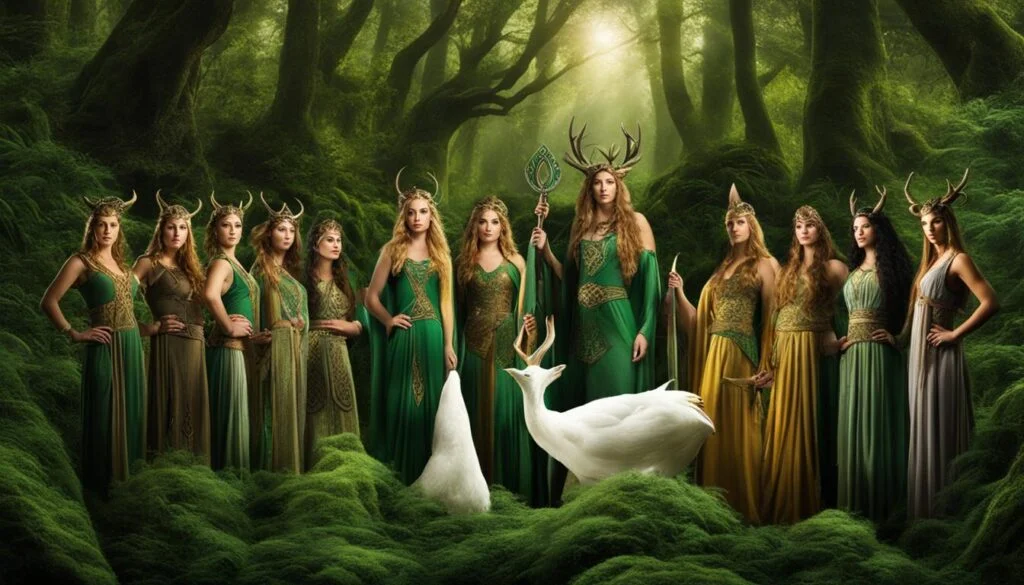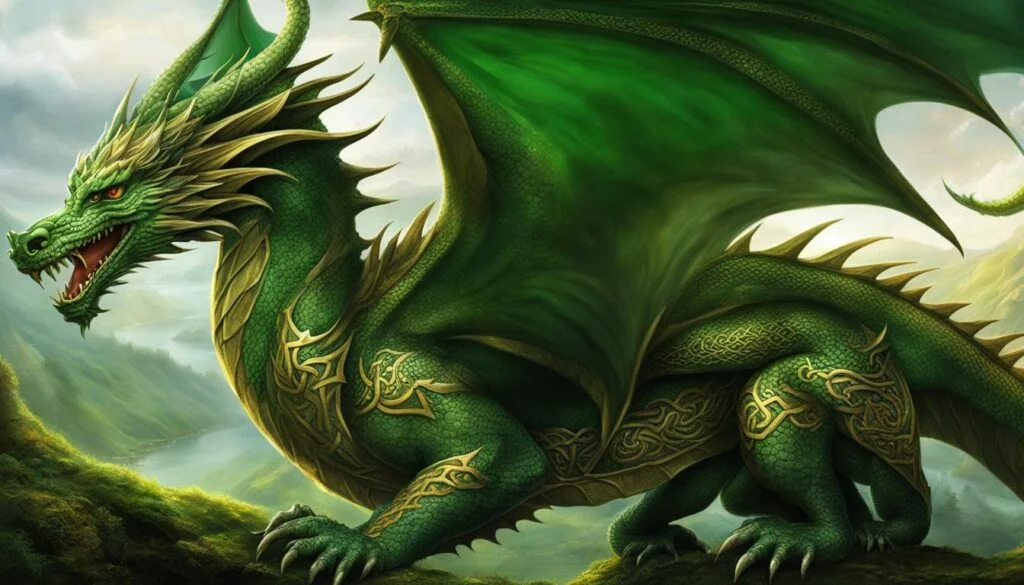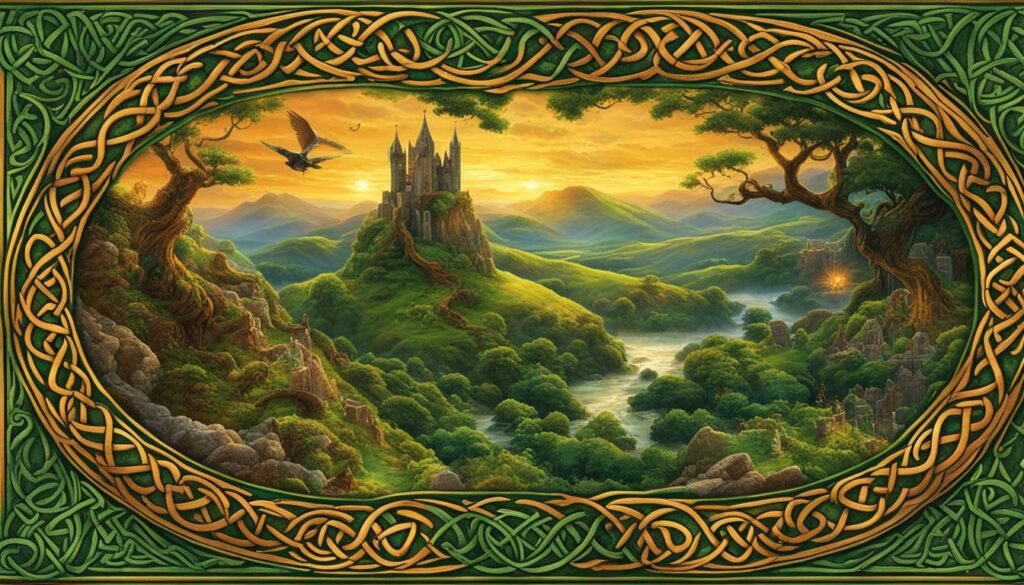Welcome to our exploration of Celtic mythology and the fascinating array of gods and goddesses that populate this ancient belief system. From powerful deities associated with war and nature to wise figures revered for their wisdom and creative talents, the Celtic pantheon is an enchanting tapestry of divine beings.
Irish mythology is filled with a wide range of Celtic gods and goddesses. The Celtic people were polytheistic, worshiping multiple gods. They had as many as 300 different gods, each associated with different aspects of life and the world. Some of the major gods and goddesses in Celtic mythology include Morrigan, Brigid, Lugh, Danu, Taranis, Cernunnos, Dagda, Rhiannon, Eriu, Aine, Aengus, and more.
Key Takeaways:
- The Celtic pantheon is comprised of a vast array of gods and goddesses.
- Celtic mythology depicts gods associated with war, nature, wisdom, and creativity.
- Major gods and goddesses in Celtic mythology include Morrigan, Brigid, Lugh, Danu, Taranis, Cernunnos, Dagda, Rhiannon, Eriu, Aine, and Aengus.
- The Celtic people worshipped multiple gods, with as many as 300 different deities.
- Each god and goddess in Celtic mythology had their own unique powers and associations.
The Goddess Morrigan
The Celtic mythology is replete with fascinating deities, and one prominent figure is the powerful goddess Morrigan. Also known as ‘Morrigu’, she holds the title of the ‘Queen of Demons’ or the ‘Phantom Queen’ in Celtic mythology. Morrigan is often depicted as a trio of sisters or a single entity, reflecting her multi-faceted nature.
Morrigan’s role as a goddess of war is central to her character. She possesses the ability to predict the outcomes of battles and has the power to inspire or frighten warriors. Her influence on warfare was immense, making her a feared and respected figure. Morrigan was a member of the Tuatha Dé Danann, married to the god Dagda, and was the daughter of Ernmas.
The enigmatic Morrigan continues to captivate our imaginations with her complex persona and her ability to straddle the realms of war and the supernatural. Her presence in Celtic mythology reflects the importance of strength and battle prowess in the ancient Celtic culture.
The Goddess Brigid
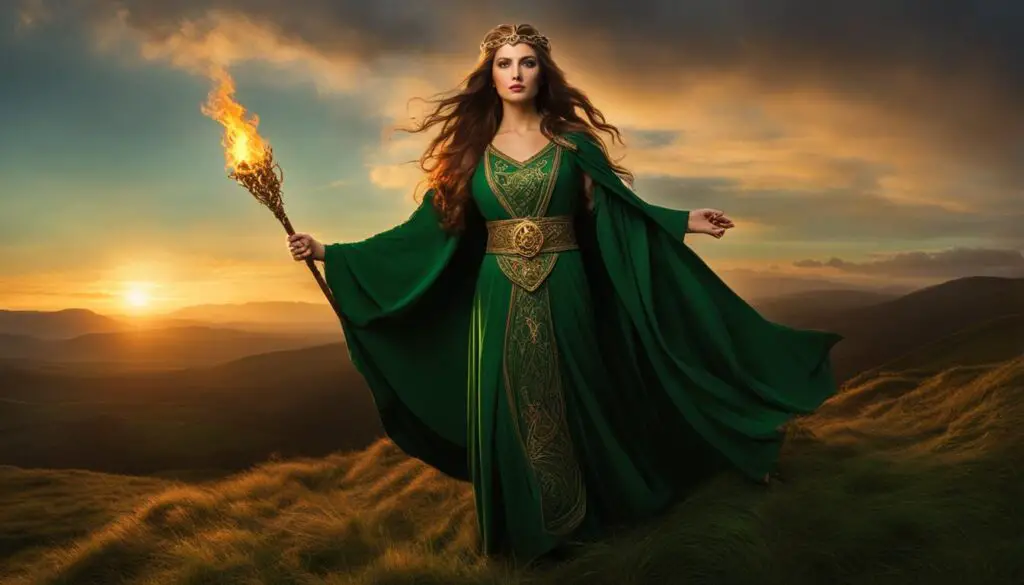
In Celtic mythology, Brigid is a revered goddess associated with various domains including fire, healing, agriculture, prophecy, and poetry. She is a wise sage adored by poets and is often regarded as a triple deity, with two sister aspects named Brigid the healer and Brigid the smith. Brigid holds a significant place among the Tuatha Dé Danann, the divine beings of ancient Irish mythology.
As the goddess of fire, Brigid symbolizes the transformative power of this element. Fire represents not only physical warmth and light, but also the burning passion of creativity and inspiration. Brigid’s connection to healing emphasizes her role in bringing physical and spiritual well-being to the Celtic people. Additionally, her association with agriculture showcases her influence on the fertility of the land and the abundance of crops.
The triple goddess aspect of Brigid reflects her multifaceted nature. Brigid the healer is known for her ability to cure ailments and bring comfort to those in need. Brigid the smith represents the forge and the transformative power of fire in crafting tools and weapons. Together, they form a trinity that embodies the essence of Brigid’s diverse domains and attributes, making her a beloved figure in Celtic mythology.
The God Lugh
Lugh, widely revered as one of the most prominent deities in Celtic mythology, is a multifaceted god associated with the sun, light, and various crafts. As the god of sun and light, Lugh embodies the illuminating and life-giving qualities of these celestial bodies, symbolizing warmth, growth, and enlightenment. His presence brings brightness and vitality to the world, casting away darkness and paving the way for new beginnings.
However, Lugh’s influence extends far beyond his association with the sun and light. He is also celebrated as the god of arts and crafts, embodying the creative spirit and mastery of various artistic disciplines. Known as “long hand” or “equally skilled in many arts,” Lugh showcases his expertise in areas such as music, poetry, storytelling, and metalworking. His diverse talents inspire creativity and innovation, encouraging individuals to explore their own artistic abilities.
The Role of Lugh in Celtic Mythology
In addition to his associations with the sun, light, and arts, Lugh holds a significant place in Celtic mythology as a skilled warrior, king, and savior. He is a member of the Tuatha Dé Danann, a divine race of supernatural beings, and his prowess in battle is unmatched. Lugh’s strategic skills and bravery make him a formidable protector of his people, ensuring their safety and victory in times of conflict.
Lugh’s multifaceted nature also extends to his role as a master craftsman. He is often depicted wielding various weapons and tools, showcasing his skill in forging powerful weapons or creating intricate artifacts. This aspect of Lugh highlights his connection to the craftsmanship and the importance of skilled labor in Celtic society.
The Goddess Danu
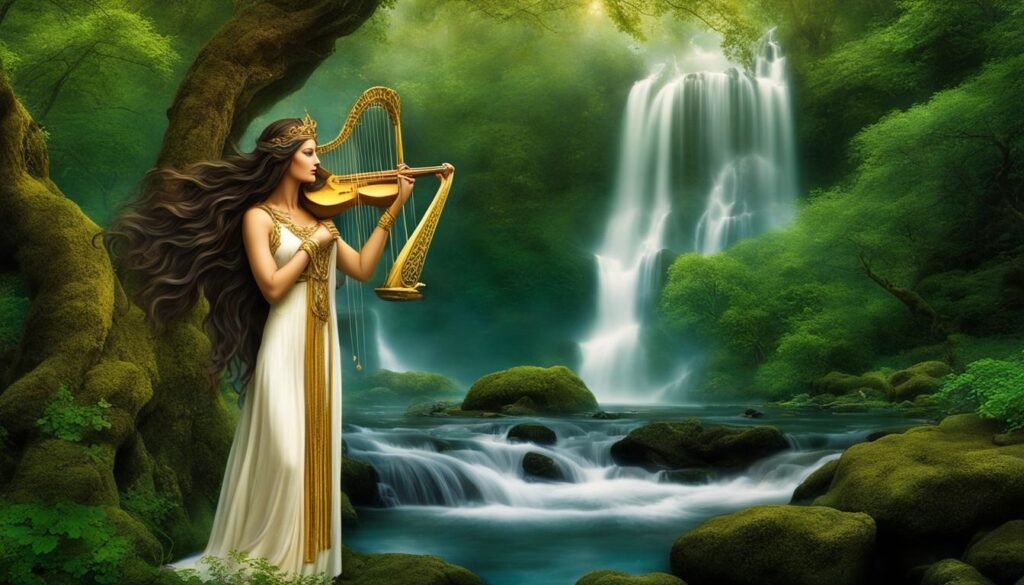
In Celtic mythology, the Goddess Danu holds a prominent place as the mother goddess of the Irish gods. She is revered as the progenitor of the Tuatha Dé Danann, the divine clan from which all other members descend. Danu is strongly associated with nature and is often referred to as the Celtic goddess of nature. Her connection to the natural world encompasses various aspects, including regeneration, wisdom, death, and prosperity.
As the embodiment of nature, Danu is considered a wise and crafty goddess. She is revered for her creative talents and her ability to bring forth abundance and prosperity. In Celtic culture, Danu symbolizes the cycles of life and the interconnectedness of all living beings. She teaches us the importance of respecting and honoring the natural world.
Manifestation and Symbolism
Danu is often depicted as a graceful and beautiful goddess, radiating an aura of wisdom. She is portrayed with long flowing hair, symbolizing the fertility and growth of the natural world. Flowers and plants are often incorporated into her imagery, representing the abundance and vitality she brings.
Additionally, Danu is sometimes depicted holding a cauldron, symbolizing the transformative power of nature and the cycle of life, death, and rebirth. This imagery emphasizes her role as the mother goddess and the source of all existence.
Worship and Influence
Throughout Celtic history, Danu was worshiped as a deity of great importance. Her influence extended beyond the realm of nature and encompassed areas such as magic, wisdom, and protection. Many ancient Celtic rituals, festivals, and celebrations were dedicated to honoring her and seeking her blessings.
Today, the legacy of the Goddess Danu lives on in various forms of modern spiritual practices. Her teachings and symbolism continue to inspire individuals who seek a deeper connection with nature and a greater understanding of the cycles of life.
The God Taranis

In Celtic mythology, Taranis is revered as the powerful god of thunder. Associated with the forces of nature, Taranis wields immense power over storms and lightning. He is often depicted with a sacred wheel, symbolizing the speed and unpredictability of thunderstorms. As the god of thunder, Taranis holds a prominent position in Celtic mythology and is highly regarded for his influence over the natural world.
Tuireann, as Taranis is known in Irish mythology, is not only a god of thunder but also represents the raw power and unpredictability of nature. His ability to control the forces of storms and lightning showcases his dominance over the elements. The concept of Taranis highlights the awe and reverence with which the ancient Celts regarded the power of nature.
Characteristics of Taranis:
- God of thunder and lightning
- Associated with storms and natural forces
- Depicted with a sacred wheel symbolizing thunderstorms
- Signifies raw power and unpredictability of nature
Tuireann, the Celtic god of thunder, brings forth a sense of awe and respect for the forces of nature. Through his embodiment of thunder and lightning, Taranis emphasizes the importance of natural elements in Celtic mythology and the power they hold over the world.
The God Cernunnos
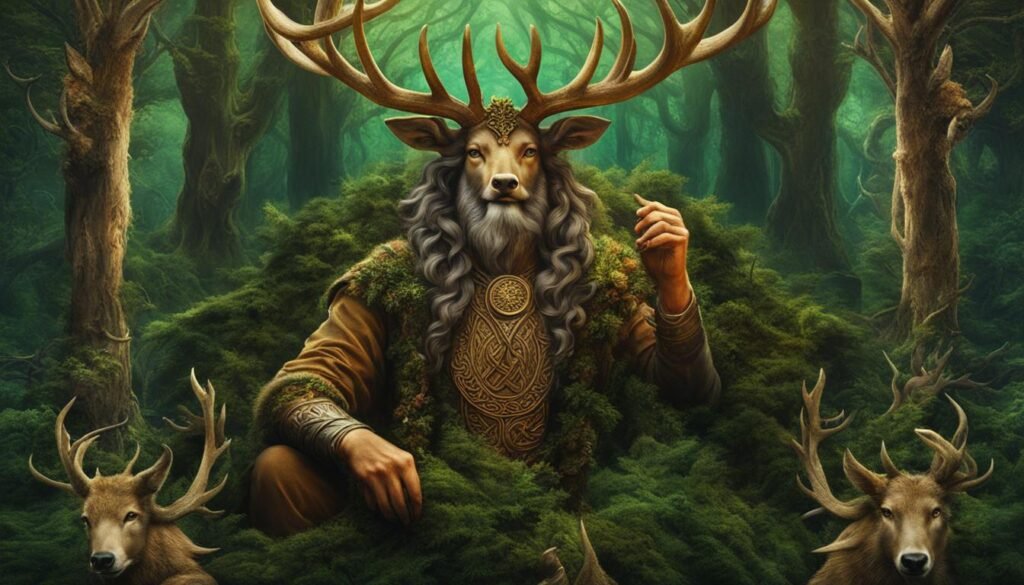
In Celtic mythology, Cernunnos is a powerful deity often referred to as the ‘Horned One’. As the god of wild things, he is closely associated with nature and the untamed wilderness. Cernunnos is typically depicted with antlers on his head, symbolizing his connection to the animal kingdom and the cycles of life and death. He is commonly associated with stags, dogs, bulls, and horned serpents, representing his dominion over various aspects of the natural world.
Cernunnos is often shown holding a torc, a metal band that signifies his status and authority. This divine figure is sometimes depicted with a bag of coins, symbolizing wealth and abundance, as well as a cornucopia, representing prosperity and bounty. These attributes highlight Cernunnos’ role as a deity of fertility, abundance, and the renewal of life.
The Symbols and Worship of Cernunnos
As a prominent figure in Celtic mythology, Cernunnos holds great significance among ancient Celtic cultures. His symbolism and worship were deeply rooted in the natural world, and he was often revered as a guardian of the wild and the sacred groves. People would seek his blessings for prosperity, fertility, and a harmonious connection with nature.
- Antlers: The antlers worn by Cernunnos symbolize his association with the animal kingdom and the cycles of life and death.
- Torc: The torc represents Cernunnos’ status and authority, signifying his role as a powerful deity.
- Bag of Coins: The bag of coins symbolizes wealth and abundance, highlighting Cernunnos’ role as a deity of prosperity and material well-being.
- Cornucopia: The cornucopia represents abundance and the bountiful gifts of the earth, further emphasizing Cernunnos’ association with fertility and the renewal of life.
Today, Cernunnos continues to be honored and revered by modern Pagans and followers of Celtic spirituality. His presence serves as a reminder of the sacredness of the natural world and the interconnectedness of all living beings.
The God Dagda
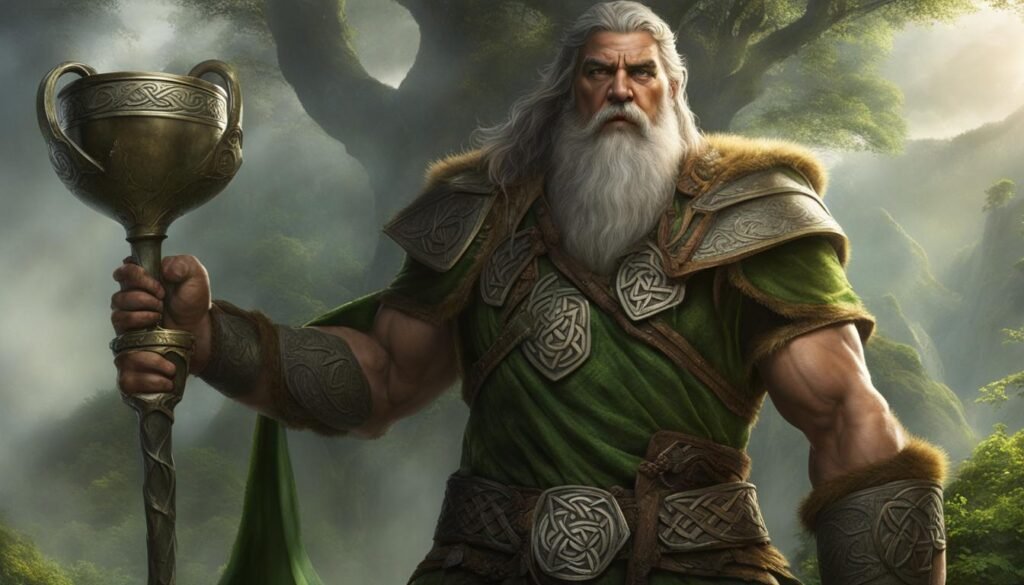
In Celtic mythology, the God Dagda holds a significant role as the god of earth and many other domains. He is revered for his association with fertility, agriculture, strength, wisdom, magic, and druidry. Depicted as a giant bearded man wearing a hooded coat, Dagda is the leader of the Tuatha Dé Danann, a divine group of beings.
The Wielder of the Magic Club
One of the most iconic attributes of Dagda is his possession of a magic club. This club holds the power to bring life or death, making Dagda a force to be reckoned with. The magic club is symbolic of Dagda’s authority and his ability to shape the world around him through his immense power.
A Multifaceted God
Dagda is known for his versatility and represents various aspects of life. As the god of earth, he ensures the fertility of the land, allowing for abundant harvests. With his wisdom and druidic knowledge, Dagda imparts guidance and counsel to both mortals and divine beings. His strength and magical abilities make him a formidable protector and a force to be reckoned with.
- God of earth and fertility
- Associated with wisdom, druidry, and magic
- Symbolized by his magic club
- Leader of the Tuatha Dé Danann
The God Dagda holds a significant place in Celtic mythology, embodying the power of the earth and the multifaceted nature of existence. His attributes and role within the Tuatha Dé Danann demonstrate his importance in ancient Celtic culture and belief systems.
The Goddess Rhiannon
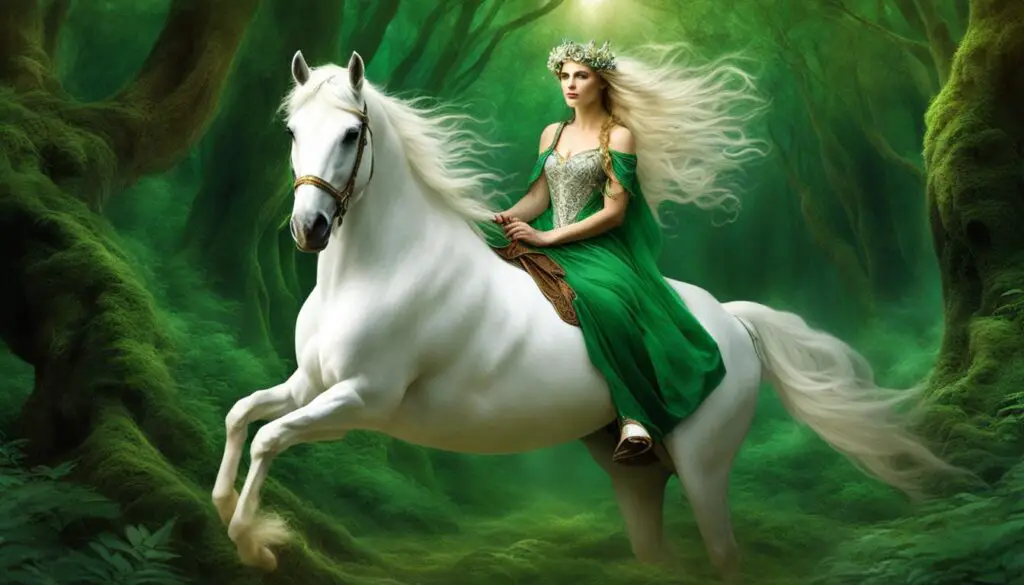
In Celtic mythology, Rhiannon is a revered goddess associated with fertility, rest, communication, and leadership. She holds the title of the divine queen of the fairies and is often referred to as the Celtic goddess of the moon. Rhiannon’s significance lies in her connection to horses, as she is recognized as a symbol of fertility.
Rhiannon’s role as a leader and communicator is evident in her ability to influence and guide people. She is known for her soothing and melodic voice, which can enchant and captivate those who listen. Rhiannon possesses the power to bring rest and peace to those who seek solace, making her a comforting presence in times of need.
As the divine queen of the fairies, Rhiannon embodies the magic and enchantment of the fairy realm. She is often depicted riding a white horse, representing her connection to fertility and the wild forces of nature. Rhiannon’s association with horses extends beyond symbolism, as she is known to possess the ability to transform into a mare herself.
The Goddess Eriu
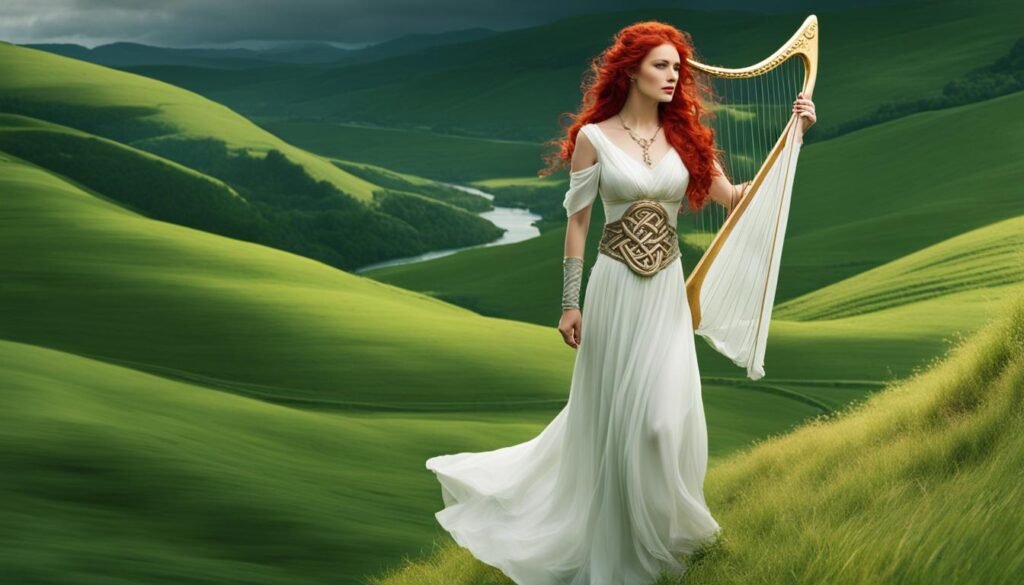
Eriu, also known as Eriu, is a prominent goddess in Celtic mythology. She holds a special place as the goddess of Ireland itself, representing the land and its abundance. Eriu is associated with fertility, sovereignty, and prosperity, making her a figure of great importance in Celtic culture.
As one of the members of the Tuatha Dé Danann, Eriu is the sister of Banba and Fódla. According to legend, these three sisters requested that their names be given to the land, with Eriu being the origin of the country’s name – Ireland. This connection to the very identity of the land solidifies her status as a divine figure deeply rooted in the Celtic people’s history and mythology.
Eriu’s role as the goddess of Ireland highlights her significance in Celtic society. She represents the bountiful nature of the land, ensuring its fertility and abundance for the people. Additionally, her association with sovereignty links her to the political structure and rulership of the land. Eriu embodies the harmony between the natural and human realms, symbolizing the interconnectedness of the Celtic people with their environment.
With her divine presence and associations, Eriu remains an essential deity in Celtic mythology. Her influence extends beyond her role as a goddess, shaping the cultural and spiritual beliefs of the Celtic people. As we explore the rich tapestry of Celtic gods and goddesses, Eriu’s presence stands out as a testament to the enduring power and reverence given to the land and its divine guardians.
Eriu: Goddess of Ireland, Abundance, and Sovereignty
- Eriu is the goddess of Ireland, representing the land and its abundance.
- She is associated with fertility, sovereignty, and prosperity.
- Eriu is one of the Tuatha Dé Danann, with her sisters Banba and Fódla.
- The three sisters asked that their names be given to Ireland, with Eriu being the source of the country’s name.
- As the goddess of Ireland, Eriu embodies the harmony between the natural and human realms.
- Her influence extends beyond mythology, shaping the cultural and spiritual beliefs of the Celtic people.
Conclusion
In conclusion, Celtic mythology is a fascinating world filled with a diverse array of gods and goddesses. These deities played integral roles in the lives of the Celtic people, with each one representing different aspects of the natural world, human experiences, and the divine. From the fierce and awe-inspiring Morrigan, the goddess of war, to the nurturing and wise Brigid, the goddess of fire, the Celtic pantheon is a testament to the depth and complexity of ancient beliefs.
Through their mythological stories and worship, the Celtic gods and goddesses provided guidance, inspiration, and protection to the Celtic people. The myths and legends surrounding these deities were not only a source of entertainment, but also served as a way to make sense of the world and the forces at play within it.
Our exploration of Celtic mythology has delved into the lives and attributes of some of the most prominent deities, including Lugh, Danu, Taranis, Cernunnos, Dagda, Rhiannon, and Eriu. Each of these gods and goddesses brings something unique to the rich tapestry of Celtic mythology, representing different aspects of life, nature, and the human experience.
As we conclude our journey through the world of Celtic gods and goddesses, it becomes clear that their stories and significance continue to captivate and inspire us. These ancient deities remind us of the enduring power of mythology and the deep connections humans have always sought with the world around them.
FAQ
What gods are included in Celtic mythology?
Celtic mythology is filled with a wide range of gods and goddesses, including Morrigan, Brigid, Lugh, Danu, Taranis, Cernunnos, Dagda, Rhiannon, Eriu, Aine, Aengus, and more.
Who is the goddess Morrigan?
Morrigan is the Celtic goddess of war, also known as ‘Morrigu’, the ‘Queen of Demons’, or the ‘Phantom Queen’. She is often depicted as a trio of sisters or a single entity, and she could predict the outcome of battles and inspire or frighten warriors.
Who is the goddess Brigid?
Brigid is the Celtic goddess of fire, healing, agriculture, prophecy, and poetry. She is considered a wise sage and is sometimes associated with a Celtic triple goddess. Brigid is a member of the Tuatha Dé Danann and is known for her association with these various aspects of life.
Who is the god Lugh?
Lugh is a Celtic god associated with the sun, light, and various crafts. He is depicted as a skilled warrior, king, savior, and master craftsman. Lugh is known for his expertise in multiple disciplines and is often called “long hand” or “equally skilled in many arts”.
Who is the goddess Danu?
Danu is the mother goddess of the Irish gods and is strongly associated with nature, regeneration, wisdom, death, and prosperity. She is the progenitor of the Tuatha Dé Danann, with all members of the clan descending from her.
Who is the god Taranis?
Taranis, also known as Tuireann in Irish mythology, is the Celtic god of thunder. He is easily recognizable by his sacred wheel, which represents the speed at which storms can catch humans off guard. Taranis is also known for wielding a thunderbolt as a weapon.
Who is the god Cernunnos?
Cernunnos is a powerful Celtic deity known as the ‘lord of wild things’. He is often depicted with antlers and is associated with stags, dogs, bulls, and horned serpents. Cernunnos is usually shown with a torc, a metal band representing status, and is sometimes depicted with a bag of coins and a cornucopia.
Who is the god Dagda?
Dagda is a prominent figure in Celtic mythology, known as the ‘good god’. He is associated with fertility, agriculture, strength, wisdom, magic, and druidry. Dagda is depicted as a giant bearded man wearing a hooded coat, and he is believed to possess a magic club that can bring life or death.
Who is the goddess Rhiannon?
Rhiannon is a Celtic goddess associated with fertility, rest, communication, and leadership. She is sometimes called the ‘goddess of the moon’ and is considered the ‘divine queen of the fairies’. Rhiannon is known for her association with horses and is a symbol of fertility.
Who is the goddess Eriu?
Eiru, also known as Eriu, is the goddess of Ireland itself. She is associated with fertility, abundance, and sovereignty. Eriu is one of the Tuatha Dé Danann and is the sister of Banba and Fódla. According to legend, the three sisters asked that their names be given to Ireland, with Eriu being the origin of the country’s name.
What is the significance of Celtic gods and goddesses in mythology?
Celtic mythology is rich with a variety of gods and goddesses, each with their own unique powers and associations. From war and fertility to sun and nature, these deities played important roles in Celtic culture and belief systems.


